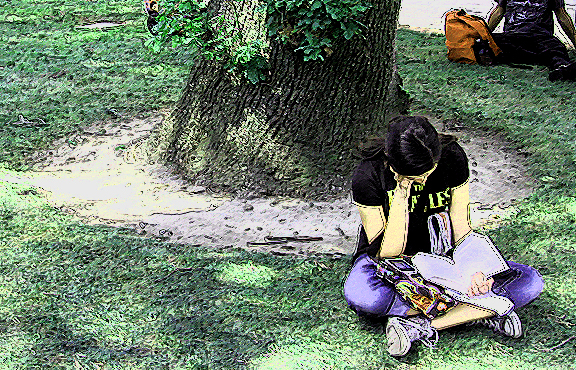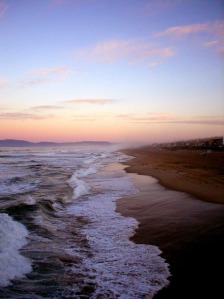My intention today was to photograph at a local botanical garden. I had been planning to do this for quite a while and was waiting for a sunny spring day. Today seemed like it would be that day. However, as I was driving towards the garden, on a whim I made a right turn instead of a left and ended up on the edge of a rocky point overlooking the Pacific. The point is a popular place for whale-watching enthusiasts who spend hours watching and counting marine mammals.
The group seemed to be looking in the same direction with their scopes. I tried to discreety come behind each watcher as she or he intently scanned the ocean. I was not successful in seeing anything they were seeing (of course, I did not have a scope of any sort). All of a sudden, the members of the group got excited. “There she is!” one called out. “I see the calf,” said another. A woman quickly scratched something in a notebook.
I trained my eyes on the patch of water. Then I saw a dark gray hump emerge a few inches above the surface and blow a few white frothy bubbles. I am amazed at the keen eyes and the patient dedication of these watchers. I would have missed this if I had not been watching where the watchers watched.
 Trust me: there is a whale cow and her calf right under the surface smack in the middle of this picture.
Trust me: there is a whale cow and her calf right under the surface smack in the middle of this picture.
I watched for a while longer and then decided that I would leave the watchers to what appears to be a form of meditation for them. Before I left, I took a shot of their tally board.
 I don’t know why I came here today. The garden would have been lovely. The garden, though, in all its beauty, is still a human-made thing. Today I think I needed to go someplace where wild things lived. I needed to see the untamed. Let’s face it: this April was not a great month for the world situation in general and a lot of people in particular — (Boston, Texas, Syria, Bangladesh to name a few). Watching this whale mother and her baby migrate north to Alaska as her ancestors have done for thousands and thousands of years filled me with a great deal of comfort.
I don’t know why I came here today. The garden would have been lovely. The garden, though, in all its beauty, is still a human-made thing. Today I think I needed to go someplace where wild things lived. I needed to see the untamed. Let’s face it: this April was not a great month for the world situation in general and a lot of people in particular — (Boston, Texas, Syria, Bangladesh to name a few). Watching this whale mother and her baby migrate north to Alaska as her ancestors have done for thousands and thousands of years filled me with a great deal of comfort.
In spite of the human-created chaos around us, some things are constant.










